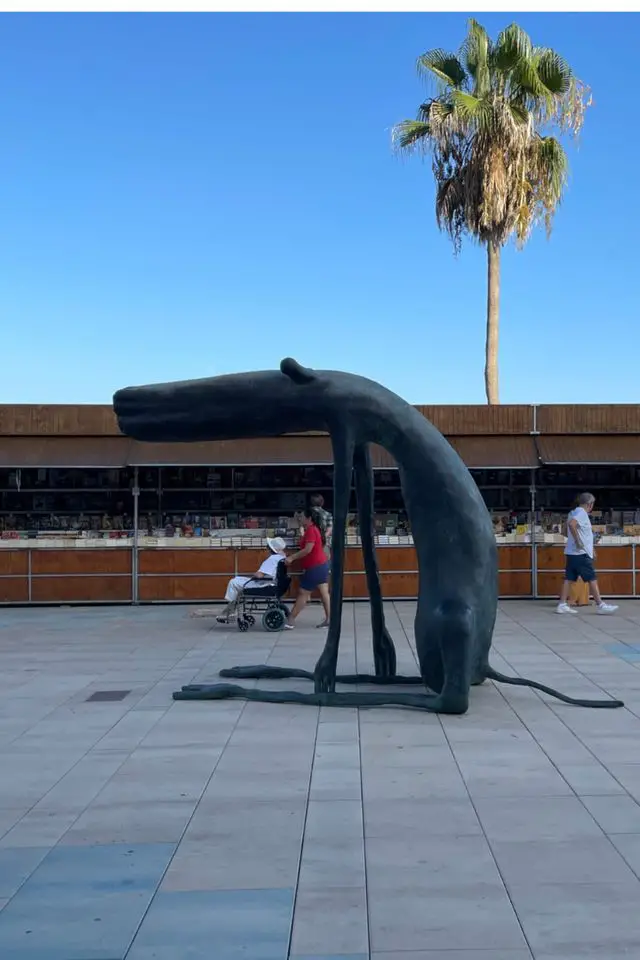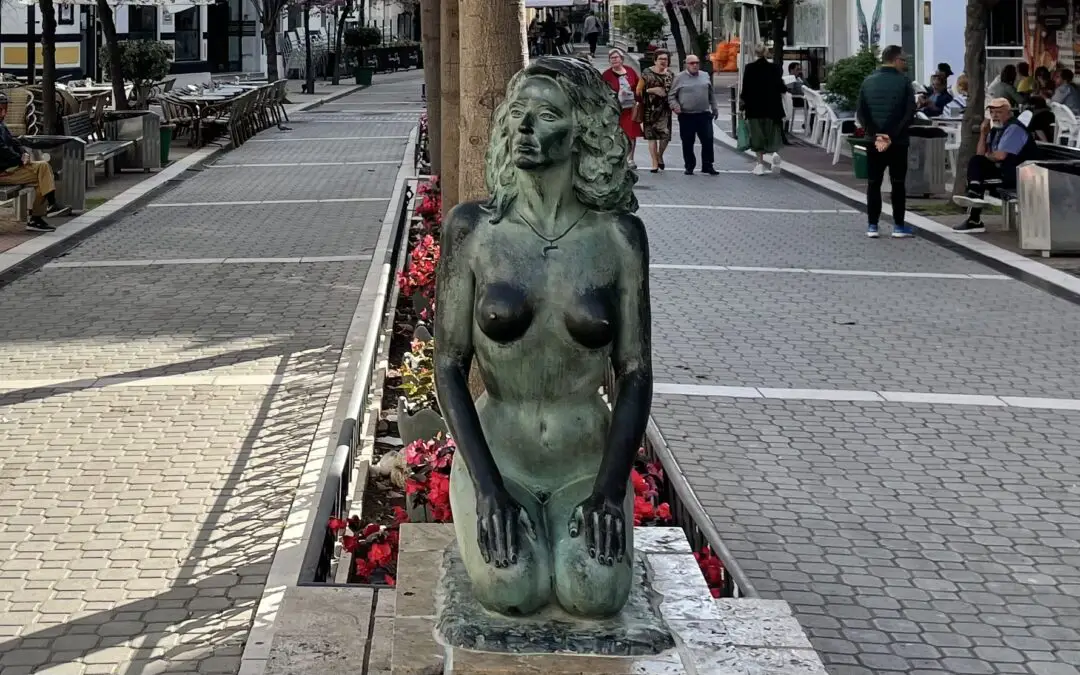It can be said that Estepona is not limited to the Paleontological Museum, the Archaeological Museum and the recently opened Mirador del Carmen, although it is not yet ready for exhibitions. Estepona is an open air museum where you can enjoy and learn about art in an original and free way.
The streets of Estepona are even more attractive for tourists and locals alike thanks to the wonderful sculptures that adorn them. The murals and poetry, created by local, national and international artists, are one of the town’s greatest charms.
Santiago de Santiago
When mentioning the Sculpture Route, composed of more than fifty works distributed in different places, it is necessary to highlight the space dedicated to the renowned sculptor Santiago de Santiago, who recently passed away. This space is located in the “El Angel” park, next to the sea, and was inaugurated in May 2018. Its visit is a must for art lovers and for those interested in the work of this great artist.
The “El Angel” park is already a museum of outdoor sculptures and has a dozen works by Santiago de Santiago, including a set of eight nymphs (Carmen, Kalima, Nemesis, Diana de Estepona, Piedad, Aesthetics, P.V. and Sparrows) as well as the works Asymmetry and A Cry in the Night. All of them are made of volcanic stone, bronze and fiberglass.
In addition to these works, we can enjoy his art in many other corners of Estepona:
Mavi, made in bronze and located in the Plazoleta Ortiz was the first sculpture of this great sculptor.
Milagros, located in Plaza Blas Infante.
El amor salva, made of bronze and more than one meter high in Calle Damas.
Analiza, in Avenida Carlos Cano, was selected to participate in the 6th International Art Biennial in Beijing.
Elvia, in Calle Real, made in bronze and inspired by a woman who won a Mexican beauty contest. (Cover photo of this article)
Evasión, cast in bronze and presiding over the square that gives its name to the famous ABC newspaper.
Tatuaje, on Avenida Juan Carlos I, a golden sculpture symbolizing the embrace of a couple.
Ángel San Gabriel, in the Dome of the Hotel El Pilar in the Plaza de las Flores. (Photo below)
Santiago de Santiago is one of the most important sculptors of the 20th century and has works exhibited in cultural centers such as the Hermitage Museum in St. Petersburg, the Pushkin Museum in Moscow and the Hakone Museum in Tokyo. A self-taught artist, he studied sculpture in France, Italy and Japan, and has made busts for important figures in the world of politics and culture, including those of the presidents of different countries and members of the Spanish Royal Family.
Mariano Amaya
We have to make special mention to El Labrador y El Pescador of Mariano Amaya, which has been located in different points of the town in all its years of history, being at present in the Paseo Marítimo. It is a sculptural ensemble that has become a symbol of the city for being a vindication of its agricultural and seafaring origins.
Francisco Alarcón
Francisco Alarcón, since graduating from the Faculty of Fine Arts in Seville, has devoted his life to pictorial and sculptural creation, having traveled to cities such as Paris, Milan, Valencia, Madrid and Connecticut, among others, where he has presented various projects of decoration, painting and sculpture. We are fortunate to have several of his works in Estepona. Within the Route of the Sculptures we are talking about we find several of his works:
Homenaje a la mujer de Estepona, on Avenida Litoral.
Monumento a la Constitución, together with José Cano Mancilla, at the Parque de la Constitución.
Escudo poético, at the Palacio de Congresos.
Cristo Redentor in Calle Guadiaro next to the Nuestra Señora del Carmen church, of which the artist commented that his intention had been “to play with opposing aesthetic concepts, but at the same time complementary, such as full and empty, organic and geometric, and solid and ethereal”.

Joaquín Aguilera
Another artist who has much prominence in the works in full view throughout Estepona is Joaquín Aguilera, a resident of our municipality. By Joaquín Aguilera, we can find:
Padre Manuel, at Plaza San Francisco.
Homenaje a Juana Luna, at Parque El Calvario.
Monumento a la Peseta, between Calle Real and Calle Terraza. The sculpture, which shows a child guiding the coin like the old hoops, was not without controversy, since its reverse shows the design minted from 1946 onwards. To avoid the appearance of Franco’s effigy, the 1944 sketch was used, i.e., the obverse of the famous 1 peseta. Thus, the peseta represented is a “numismatic error” that never existed. (Photo above this section)
Monumento a la Policía Local, in Avenida del Carmen.
Monumento al Turista, between Calle Terraza and Calle Real. (Photo at the end of this section).
Tribute to Frasquito, in the gardens of the Plaza de Toros, the bullfighter from Estepona who on June 25, 1935 when he was fighting his second bull, the fourth of the bullfight, suffered a defeat, caused by the wind, an easterly wind, sticking the rapier in his right leg, and died as a result.
Tribute to Paul Naschy, in Jardines del Palacio de Congresos.
Ofelia, in Calle Guadiaro made of granite stone representing maternity, 2.5 meters high and 1.30 meters wide, has soft curvilinear shapes that offer a changing appearance during the day as the incidence of light varies.
Tony Govan
Tony Govan, el inglés afincado en España que “lee las piedras” y ve la fuerza y energía que atesoran. He explains that feelings such as affection, unity and fortitude emerge from within the stones. Through its shapes, colors and touch, it creates figures designed to be touched.
El Baile del Chal and Frescura at Casa Tejerinas.
El Abrazo a la Cultura in Jardines del Padre Manuel.
El Ascenso at the Athletics Stadium.
El Dragón al Sol in El Calvario Park that recreates a Komodo dragon.
En tus brazos on the Paseo Marítimo of three and a half tons.
Buda in Plaza Blas Infante.
La Elefanta Requetebién in Plaza Rocío Bazán.
These works are carved in a single piece of limestone material, with stones coming mostly from the Ojén quarry and the Guadalmina riverbed.
Francisco Javier Galán Domingo
Francisco Javier Galán Domingo who has the design and art management company “Mester Artis” to help other artists, resident in Antequera and collaborates with Fundiciones Artísticas del Sur. We have several of his works in our city:
Skater, in Jardines del Polideportivo El Carmen.
San Isidro Labrador, in Avenida Andalucía.
Costaleros, in Plaza Almengual. A beautiful bronze sculpture made in 2007 for the 25th anniversary of the Brotherhood of the Triumphal Entry into Jerusalem, Holy Christ of Love, Our Lady of Hope and Mary Immaculate.
Juan Miguel Quiñones
Juan Miguel Quiñones is a native of Vejer, Cádiz, and lives in Estepona. His relationship with stone is the result of a lifetime of working this and other hard, untiring materials. He delights us with:
Elogio a la Fantasía, in the Parque de los Niños, which pays homage to children’s innocence with a large tricycle that seems to take flight at any moment.
Levante, in Calle Guadiaro that recognizes the importance of the east wind in the culture of our city.
Andrés Montesanto
Andrés Montesanto has left us his art with the sculpture in the Mirador del Ciclista at km 8.5 uphill Peñas Blancas that represents two cyclists.
Elena Lucas
We only have one woman, Elena Lucas, a Catalan/Spanish sculptor-painter who currently lives in Benalmádena (Málaga). At the age of 10 he began what would become his professional career, entering with his father in an artist’s workshop in Barcelona, where with a piece of clay he began to make his first figures. She created Jardín de los Poetas Andaluces in Jesus Cautivo Street, with 12 artists who are part of this enclave dedicated to the Andalusian letters.

Rafa Macarrón
By Rafa Macarrón, one of the most promising contemporary artists in the country, we have Perro I (photo above) at the Paseo Marítimo. One piece, which is made of bronze, weighs more than one ton and is two meters high. It was donated by the Kronos group to Estepona, and I must confess that it is one of my favorites.
I hope that after this tour you have felt like getting lost with us in search of the sculpture that most impacts you and share with us which one you choose. To make the tour easier, you can download a pdf map of Estepona in which you will find indicated each of the works that make up the Route of the Sculptures of Estepona.

You may also be interested in:
> The route of the Estepona murals
> A must-see: the dolmens of Corominas
> 9 parks in Estepona not to be missed
> The route of the Sculptures of Estepona: an open-air museum
> A different day in Parque de los Pedregales
> What to do this weekend in Estepona


